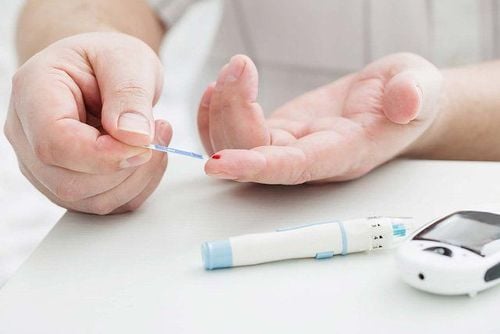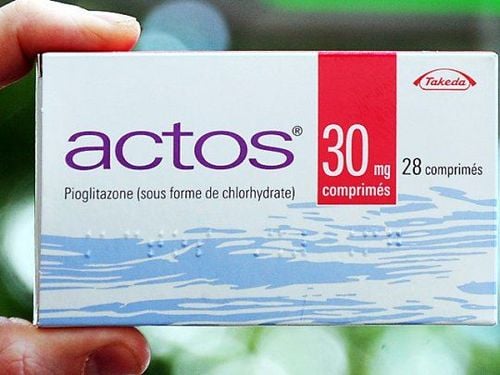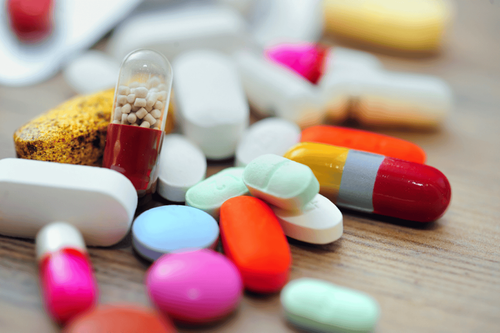This is an automatically translated article.
Nateglinide can be used alone or in combination with other medications along with a suitable diet and exercise program to control blood sugar in people with diabetes. Controlling high blood sugar helps prevent kidney damage, blindness, nerve problems, amputation and sexual function problems, and reduces the risk of heart attack or stroke.1. What does Nateglinide do?
Nateglinide works by stimulating the body to produce more insulin, thereby helping the body use sugar from the diet properly.Nateglinide is contraindicated in cases of:
Type 2 diabetes Nateglinide is contraindicated in cases of:
Low blood sugar
2. How to use Nateglinide?
Read the medication guide provided by your doctor before you start using nateglinide and each time you get a refill. If you have any questions about how to use Nateglinide, consult your doctor.Nateglinide is to be taken by mouth 1-30 minutes before each main meal, usually 3 times daily, or as directed by your doctor. Do not take the medicine earlier than 30 minutes before each meal. Do not take the medicine if you are skipping a meal afterwards.
If you are taking liquid foods, a higher dose of Nateglinide may be needed to control your blood sugar.
Nateglinide dosage is calculated based on your medical condition, number of meals per day and response to treatment.
Use Nateglinide regularly as directed by your doctor to get the most benefit from it. You need to carefully follow the medication treatment plan, eating plan, and exercise program your doctor has recommended.
Check your blood sugar regularly, track the results and share them with your doctor. This is very important to determine the correct dose of the drug. Tell your doctor if the results show that your blood sugar is too high or too low.
Attend diabetes education programs to learn more about how to control your diabetes with medication, diet, and exercise. Learn the symptoms of high and low blood sugar conditions and how to treat low blood sugar.
Tests such as kidney function tests, liver function tests, fasting blood sugar, hemoglobin A1c should be done while you are taking Nateglinide.

Thuốc Nateglinide có tác dụng kích thích cơ thể sản xuất insulin nhiều hơn
3. Nateglinide side effects
When you are treated with Nateglinide, you may gain weight. If this effect persists or worsens, tell your doctor right away.Remember that your doctor has prescribed this medicine for you because he or she has judged that the benefit to you is greater than the risk of side effects. Many people use Nateglinide without any serious side effects.
Nateglinide may cause hypoglycemia, especially if you are taking other medicines for diabetes. Drinking large amounts of alcohol, not getting enough calories from food, or exercising unusually hard can also lead to hypoglycemia.
Symptoms of hypoglycemia you may experience include chills, cold sweats, dizziness, drowsiness, tremors, heart palpitations, headache, fainting, weakness, tingling in the hands or feet or hunger. You should carry glucose tablets or gels to treat hypoglycemia.
Otherwise raise your blood sugar quickly by eating a quick source of sugar like table sugar, honey, candy, or drinking a glass of fruit juice or regular soda water.
Symptoms of hyperglycemia include increased thirst, increased urination, drowsiness, confusion, flushing, rapid breathing and fruity breath. If you develop these symptoms, tell your doctor right away.
A very serious allergic reaction to Nateglinide is very rare. However, if you notice any of the following symptoms of a serious allergic reaction to Nateglinide: Rash, itching/swelling (especially of the face/tongue/throat), trouble breathing, dizziness, get medical help. seek medical attention immediately.
Below are Nateglinide side effects by likelihood.
Common side effects of Nateglinide include:
Common cold Weight gain Less common side effects of Nateglinide include:
Low blood sugar Bronchitis Arthritis Back pain Dizziness Symptoms like flu Cough Diarrhea Rare side effects of Nateglinide include:
Abnormal liver function tests Hypersensitivity reactions to the drug Hepatitis Yellowing of the eyes or skin due to accumulation of bilirubin. Itching Leech's Nest Skin Rash This is not a complete list of possible side effects of Nateglinide. If you notice other side effects of Nateglinide not listed above, contact your doctor for proper handling.

Cảm lạnh là một trong các tác dụng phụ thường gặp của thuốc Nateglinide
4. Measures to prevent side effects of the drug Nateglinide
Before taking nateglinide, tell your doctor if you are allergic to this medicine and any other allergies, if any. Nateglinide products may contain ineffective ingredients that can cause allergic reactions or other problems.Before using Nateglinide, tell your doctor your medical history, especially of: Kidney disease, liver disease, gout.
Blood sugar that is too low or too high can cause blurred vision, dizziness or drowsiness. Do not drive, use machinery, or perform any activity that requires alertness or clear vision until you are sure you can do them safely.
Limit alcohol while taking Nateglinide as it may increase the risk of developing hypoglycemia.
During times of fever, infection, injury or surgery, it may be harder for you to control your blood sugar. Consult your doctor as these conditions may require changes to your treatment plan, medications, or blood sugar testing.
For women during pregnancy, Nateglinide should be used only when clearly needed. Pregnancy can worsen diabetes or cause gestational diabetes. Discuss with your doctor a plan to manage your blood sugar during pregnancy. Your doctor may change your diabetes treatment during your pregnancy.
We do not know if Nateglinide passes into breast milk, women who are breastfeeding should consult their doctor before use.

Trước khi sử dụng thuốc Nateglinide, hãy cho bác sĩ biết tiền sử bệnh của bạn
5. Nateglinide drug interactions
Drug interactions can change the way nateglinide works or increase your risk of serious side effects. Tell your doctor about all prescription/nonprescription drugs and herbal products you use. Do not start, stop, or change the dose of any medicine during Nateglinide treatment without your doctor's approval.Many medications can affect blood sugar levels, making it harder to control your diabetes. These include corticosteroids (such as prednisone), psychiatric medications (such as olanzapine), fluoroquinolone antibiotics (such as ciprofloxacin), and others.
Beta blockers (like metoprolol, propranolol, glaucoma eye drops like timolol) can stop the fast/pounding heartbeat you normally feel when your blood sugar gets too low. Other symptoms of hypoglycemia such as dizziness, hunger, or sweating are not affected by these drugs.
6. What to do if you overdose or forget to take Nateglinide?
If you or someone else has overdosed on Nateglinide and has severe symptoms such as fainting or difficulty breathing, call 911 immediately. Nateglinide overdose symptoms may include: Very fast heartbeat, vision changes, unexplained heavy sweating, agitation, fainting, seizures.If you miss a dose of Nateglinide, skip the dose. Take your next dose of Nateglinide with your next meal, do not double the usual dose.

Nếu bạn bỏ lỡ một liều Nateglinide, hãy bỏ qua liều đó
7. How to store the drug Nateglinide
Store Nateglinide at room temperature, away from light and moisture, do not store in the bathroom, keep it away from children and pets.Dispose of the Nateglinide product appropriately when it expires or is no longer needed by you.
Please dial HOTLINE for more information or register for an appointment HERE. Download MyVinmec app to make appointments faster and to manage your bookings easily.
Reference source: webmd.com












